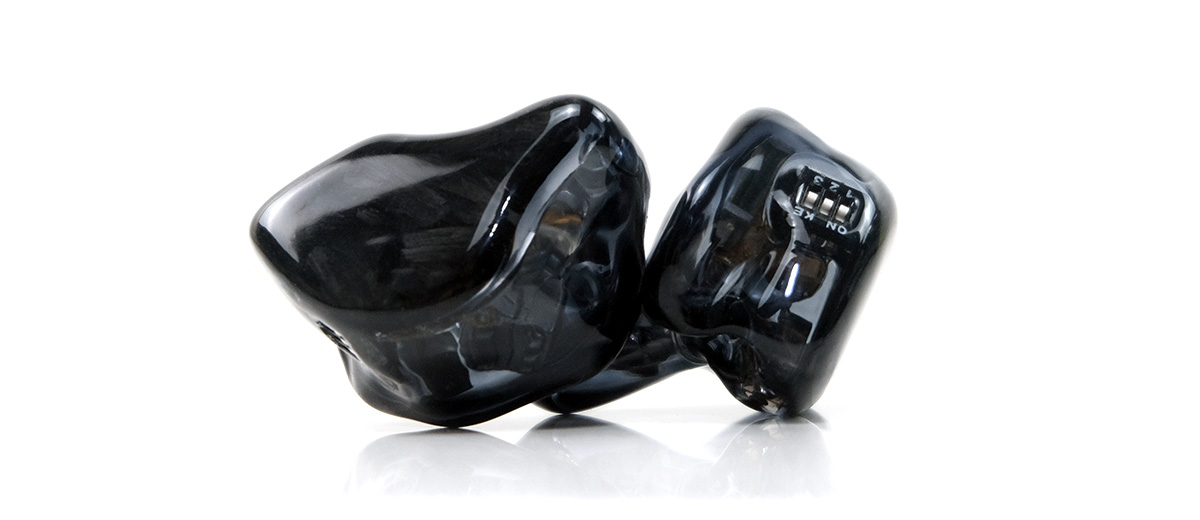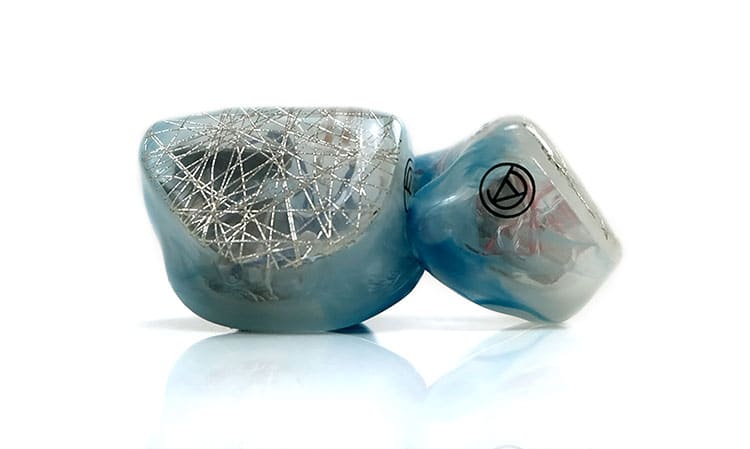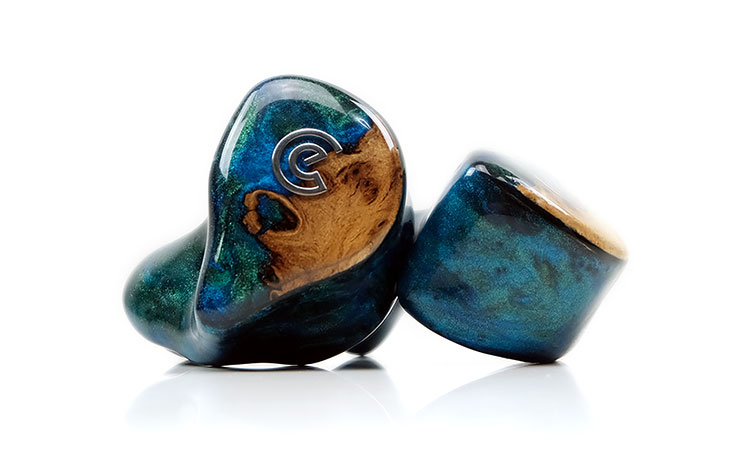Select Comparisons
The following comparisons of the Omegon MK2 default tuning were completed using a mixture of the iBasso DX320 with AMP12, HiBy’s RS8, and the Chord Electronics Mojo 2. All compared monitors are in custom format with their stock cables.
qdc Anole V6
The qdc Anole V6 was launched in 2018 with our review coming shortly after in early 2019. Of the three compared it is the only one with a similar dip switch style and pricing point. You can read our full review of the Anole V6 here.
Technical
Both of these monitors are 6 driver designs, however, the Anole V6 uses only Knowles BA whereas the Omegon MK2 uses a mix of Sonion BA and EST drivers.
Although not documented officially, we presume the Anole V6 has a configuration of 2 woofer BA for the lows, 2 for the mids, and 2 for the highs using dual armature modules. The Omegon MK2 also has dual driver modules with a similar dual woofer for the lows and 2 for the mids with the Sonion EST dual array for the highs.
Both of these monitors come with dip-switch capability for tuning options. However, the Anole V6 only comes with 2 switches whereas the Omegon MK2 comes with 3. That means you get a total of 4 tuning options on the Anole V6 with the Omegon MK2 going further with 7 options.
The Anole V6 is rated at 16-29Ω and the reason for that is the dip switch which is resistance-based so there is some variation in the formal rating. I presume the Omegon MK2 is the same, however, we only have one official rating which I presume is a milestone reading for the default switch-off mode at 32Ω.
It is a similar case also for SPL with the Anole V6 rated at 106-109dB SPL/mW and the Omegon MK2 rated at 104dB/mW. Both have a similar medium-efficiency rating with the key difference for me those EST drivers in the Omegon MK2 dragging the sensitivity a bit further.
In our real-world testing with a HiBy RS8 using its low-gain balanced turbo mode, I found the Omegon MK2 to be less sensitive by around 10 steps compared to the Anole V6.
Design
As they are both custom monitor formats the design choices can vary a lot. However, for these two samples, the contrast in visuals is massive and completely my fault in a good way.
Credit to qdc though they have some very creative design choices, an area Alpha Omega does well in but does not yet have such a broad range to offer.
This design is specifically called “Magic Color” which is composed of a pink/red blend on a translucent shell with a myriad of brightly colored swirls on its plate. It’s a very loud and fun design.
By contrast, the Omegon MK2 design I picked is very understated. This is a smoky black translucent shell with dark forged carbon fiber designs for the faceplates and a subtle glow from its brushstroke pattern in the dark.
qdc makes their customs a bit on the wide side so the Omegon MK2 sample I have here is narrower and more compact though both have roughly the same depth given they are custom to my ears.
Ironically, both have a very relaxed fitting. I could probably do with both of them being fattened up a bit on the nozzle though the benefit is less pressure on your ear canal giving you less fatigue in the long run. Still, the seal is above average once adjusted, and yes, I use some foam strips if I want them even tighter.
The big drawback with qdc is their reversed polarity connectors and cables. It makes cable rolling impossible without specially fitted adapters or having your cable terminated with qdc connectors. No such issues with the Omegon MK2 plus the stock cable is much better in terms of finishing and offering a lower resistance.
Performance
Testing between the Omegon MK2 and the Anole V6 was done with all the dip switches in their default off position.
Both monitors follow a relatively similar adherence to some Harman basics with a slightly lifted low-end and a solid pinna gain region from 1-4k. However, the key deviations between them happen at either end of the frequency spectrum with the tuning on the highs the most immediately noticeable difference.
The Omegon MK2’s highs are much more abbreviated beyond 7k in terms of presence and bite whereas the Anole V6 has considerably more lift around 8-9k and a dip around the 5-6k region. On the lows, both are punchy but the Anole V6 sounds a bit flatter beyond with the Omegon MK2 generating a bit more body and warmth.
The resulting tweaks change the midrange coloration substantially for me with the Omegon MK2 sounding slightly warmer and more natural in tone but also comparatively rounded and lacking in a little bit of bite and contrast.
The Anole V6 comes across as more neutral in its timbre to at times competitively brighter with a lot more brightness through the upper mids and highs but also a thinner note through the mids.
Percussion bite and splash have more presence and though I find the vocal delivery to shy away from artificial sibilance it is drier and more pristine in its timbre.
Staging perception is also different. The Omegon MK2 is darker, more bottom-weighted with a firmer focus on the 1-4k range, and less sparkle compared to the Anole V6. The V6 is shallower, more mids and highs orientated but with still some nice presence in the 1-3k range.
Custom Art FIBAE 7 Unlimited
The Custom Art FIBAE 7 Unlimited was launched in the middle of 2022 and is seen as the 2nd generation of the original FIBAE 7 from 2020. You can read our full review of the FIBAE 7 Unlimited here.
Technical
The FIBAE 7 is not a hybrid IEM like the Omegon MK2 but rather uses only balanced armature drivers with no EST arrays.
It uses a total of 7 BA drivers with a dual sub-low woofer, one low-mid, two mid-highs, one proprietary high, and one proprietary tweeter for the super highs. Two of those drivers are also top-firing drivers.
The Omegon MK2 also uses a dual sub-woofer for the lows and 2 for the mids but the EST drivers cover the highs. Whilst we know that Alpha Omega uses 100% Sonion-sourced drivers, CA is not so specific so it could be Sonion, Knowles, or both.
There are no tuning options on the FIBAE 7 Unlimited similar to the dip-switch on the Omegon MK2 so it is just one sound signature possible as opposed to seven.
The FIBAE 7 Unlimited is rated at 12Ω impedance with a sensitivity of 122 dB @1kHz which is a fair bit more sensitive on paper when compared to the Omegon MK2’s 32Ω and 104dB @1kHz SPL.
Using the iBasso DX320 with AMP12 in a low-gain balanced output configuration, I felt the numbers didn’t lie here with the Omegon MK2 needing a lot more juice to volume match the FIBAE 7 Unlimited.
Design
Credit where credit is due, the FIBAE 7 Unlimited sample we have here is a unique design, and probably more eye-catching than the design I chose for the Omegon MK2.
This is a stunning bespoke ice and wired-themed concept which I tentatively called “Harigane Ice” during the review process though do note it will cost you an additional 200 EUR which puts its overall cost a lot higher than the Omegon MK2 price.
It is also a relatively ‘fatter’ form factor compared to the Omegon MK2 and looks a little less aggressive in its curves. However, the FIBAE 7 Unlimited is also fatter through the nozzle and seals a bit better as a result given the Omegon MK2’s very relaxed fit. Neither have dynamic drivers so there is no additional venting to break that seal.
Both cables are finished really well in terms of barrels and PVC jackets. However, the cable wire choice and finishing differ considerably.
CA has used Null Audio’s 1.2m Arete as their stock cable which is a 4-wire 24AWG UP-OCC copper wire in a Litz geometry and it is indeed a bit lighter than the Omegon MK2 cable.
However, given the Omegon MK2 cable is also a 4-wire, its larger 20AWG gauge, and 6N pure silver Litz wire it gets my vote in terms of the quality of materials inside.
Performance
The FIBAE 7 Unlimited creates a more holographic presentation with better midrange separation and perceived articulation in the highs. On the whole, it’s more balanced sounding and the more flexible of the two monitors for a wider range of genre compatibility.
The FIBAE 7 Unlimited tuning dialed back on the vocal forwardness of the original FIBAE 7 to create what I believe to be a bit more ambiance in the soundstage, with more priority given to backing instruments so you can pick up on the additional staging width over the Omegon MK2 which is comparatively centered sounding.
The Omegon MK2 is firmer on the lows, with a fuller sub-to-mid-bass presentation, denser rounded vocal notes, and a more intimate soundstage akin to a large studio room or small chamber performance.
This presentation is more suitable for EDM bass synth notes and soulful vocal artists in your music collection. It also does better with presenting body and power for lower-register bass guitar plucks as well as avoiding bright mixes and overcooked sibilance.
The highs are darker on the Omegon MK2 though the FIBAE 7 Unlimited also has a similar post-7k drop so it’s fairly fatigue-free also.
Neither monitor is going to disrupt the natural flow of vocals and percussion with uneven or peaky-sounding highs though the FIBAE 7 Unlimited has a bit more amplitude in the 4-6k range and thus brings a bit more upper-mid energy to its presentation.
Craft Ears Craft 6
The Craft Ears Craft 6 was launched in early 2021 and comes in both universal and custom formats with this sample being the custom format. It has a similar price point also to the Omegon MK2. You can read our full review of the Craft 6 here.
Technical
The Craft 6 is an all-balanced armature 6 driver configuration with a dual sub for the lows, a dual for the low-mids, a single BA for the mid-highs, and one super-tweeter using a 5-way electrical crossover.
That contrasts with the hybrid approach of the Omegon MK2 which uses 4 BA and 2 EST with 2 BA for the lows, 2 BA for the mids, and the 2 EST drivers for the highs.
Both companies have targeted their bass response internally also with the PPC tech inside the Omegon M K2 for phase control between the bass and mids drivers to keep it clean and well separated.
The Craft 6 uses the company’s RASEN technology which is a fully 3D-printed structure, placed on the bass tube of the bass driver. It acts as a ‘damperless’ low pass filter with decay extension to create a connection between BA clarity and precision with the natural roundness and decay of a dynamic driver.
I also have to note that the Craft 6 uses a form of flat impedance technology similar to Custom Art and 64 Audio called True Load. I am not 100% sure that is a huge benefit these days with most dongles and DAPs well under 1Ω.
The Craft 6 has a fairly low impedance rating of 7Ω compared to the Omegon MK2’s 32Ω but makes no mention of its benchmarked SPL rating. In our subjective testing with the Chord Electronics Mojo 2, (single-ended), I found the Craft 6 to be the more sensitive of the two though the gap is not as big as with the FIBAE 7.
Design
At the risk of sounding like a stuck record, both are custom designs so the design choices are yours, and for mine that means these samples being compared look very different.
The Craft 6 visual on this sample is officially called an Ocean Blue finish and it is comprised of two parts; an ocean blue lightly speckled solid color shell finish, and a faceplate comprising of a mix of stabilized resin wood with a swirl of complimentary marine colors.
Those colors are a mix of blues and greens bending into the tan wood grains to produce a dramatic split-tone aesthetic.
It does not have the cool glow-in-the-dark effect of the Omegon MK2 design I picked but I will admit it has more visual flair and it’s a pretty nice albeit often-used design choice these days.
Of the compared models the Craft 6 is the most compact but still not quite as streamlined and as aggressive on the curves as the Omegon MK2 finishing. On the flip side, it isolates better with a firmer thicker nozzle plugging the gap a bit better compared to the relaxed fit of the Omegon MK2.
Both stock cables have a strong silvery hue with the Craft 6 version a bit lighter. This is an SPC wire instead of 6N high-purity silver inside the Omegon MK2 stock cable.
I believe the Craft 6 wiring is 26AWG though not officially declared so it has 4 more cores but likely a smaller gauge overall compared to the 20AWG 4-core 6N pure silver Litz wire inside the Omegon MK2 stock cable.
Performance
Much like the FIBAE 7 Unlimited the Craft 6 is aiming for a more balanced presentation compared to the Omegon MK2’s more colored sound signature. However, this time it’s a leaner tone, less bass weight and punch, less warmth through the mids, and a little more energy through the upper mids and highs.
You could argue that the presentation has better separation and more highs presence but I think that is more due to the flatter mid-to-upper bass and slightly leaner midrange timbre creating a perception of improved space.
Imaging is more neutral on the Craft 6 through the bass and up to around 3k then slightly north of neutral in the upper-mids and some aspects of the treble beyond 6-7k. You get a little more headroom on the Craft 6 compared to the Omegon MK2
Certainly, the Omegon MK2 has more warmth and body throughout, and of the two, it has a more intimate full-on staging quality with a stronger emotional connection. Vocals are much more to the fore as is the denser mid-bass thrust.
Both extend quite well though just that the Craft 6 mid-bass punch has far less influence on the instrumental fundamental and coloration compared to the Omegon MK2.
Its instrumental and vocal coloration isn’t overtly high in contrast, still some relative roundness to its leading edges, but it is not as liquid and rich in tone as the Omegon MK2 equivalent.
Our Verdict
The Alpha Omega Omegon MK2 is one of those rare BA/EST combos that delivers a credible level of sub-bass weight and mid-bass punch without sounding overly bloated or polite.
Most competitors will compensate to ensure the bloat and potential veil do not overpower the mids and that often means less leading to the classic “OK bass for a BA” meme. Not so, with the Omegon MK2.
Of course, with such a beefy set of lows and a stronger vocal focus, it can at times lack the holographic complexity of some of the competition out there. The use of EST for the highs and not just the ultra-highs brings in a very interesting timbral contrast but it’s not overly forced giving it a slightly dark overtone.
The switches help. They offer some good choices ranging from bass concussive to very balanced-sounding indeed. I suspect that tuning flexibility and excellent core bass tuning are where the Omegon MK2 is going to appeal the most. Oh, and the price for a custom monitor of this capability isn’t too outrageous either.
Alpha Omega Omegon MK2 Specifications
- Driver configuration: 4 Sonion BA, and dual Sonion electrostatic drivers, (triple dip switch with PCC technology).
- Frequency response: 20-20000 Hz
- Impedance: 32Ω
- Sensitivity: 104dB/mW
- Cable length: 1.2m
- Socket type: 0.78mm 2-pin
- Cable: 20AWG 4-core 6N pure silver Litz wire
- Tuning Mode: 7 in total
- Switch 1 ( Subbass)
- Switch 2 (LIVE MODE)
- Switch 3 (Treble)





